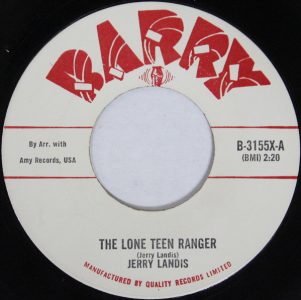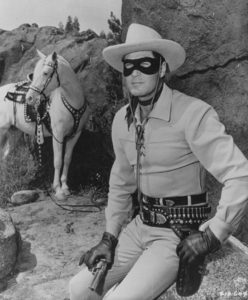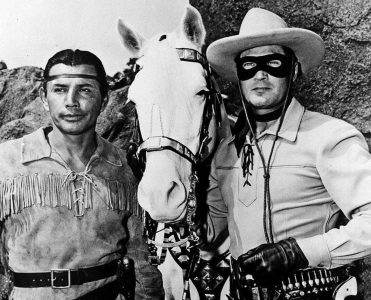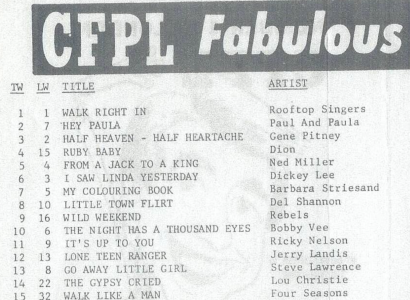#31: The Lone Teen Ranger by Jerry Landis
City: London, ON
Radio Station: CFPL
Peak Month: February 1963
Peak Position in London ~ #12
Peak position in Vancouver ~ did not chart
Peak Position on Billboard Hot 100 ~ #97
YouTube: “The Lone Teen Ranger”
Lyrics: “The Lone Teen Ranger”
Paul Frederic Simon was born in 1941 in Newark, New Jersey, to Hungarian-Jewish parents. His dad was a bandleader who went by the name Lou Sims. When he was eleven years old he met Art Garfunkel and were both part of a sixth grade drama production of Alice In Wonderland. By 1954 Paul and Art were singing at school dances. In 1957, in their mid-teens, they recorded the song “Hey, Schoolgirl” under the name “Tom & Jerry”, a name that was given to them by their label Big Records. The single reached No. 49 on the pop charts.
Simon released “Teen-Age Fool” in 1958 under the pseudonym of True Taylor. The single was not a hit. In 1961 he released “Motorcycle” under the name Tico and the Triumphs. The tune made it to #99 on the Billboard Hot 100. That musical experiment disbanded after two more single releases that were both flops. Simon also released ten singles between 1959 and 1962 under the pseudonym Jerry Landis.
The first of these was “Loneliness” in 1959. His second release, “Shy”, was a Top 30 hit in Flint (MI) in September 1960. The following month, “I’d Like to Be the Lipstick On Your Lips” made the Top 50 in Rochester (NY). In March 1961, “Play Me A Sad Song” was a Top 50 hit in Rochester (NY). Next, in the winter of 1961, “I’m Lonely” was a Top 50 hit in Winnipeg. Aside from the feelings of desire implicit in “I’d Like to Be the Lipstick On Your Lips”, the other songs Paul Simon was releasing under the pseudonym of Jerry Landis were sad songs. The Jerry Landis listeners heard singing on the radio was lonely and sad.
A variant of the lonely theme was his most successful under the Jerry Landis pseudonym, “The Lone Teen Ranger”.

Credit for “The Lone Teen Ranger” was given to Jerry Landis (aka Paul Simon). The song concerns a guy who has been steadily dating his “baby.” However, ever since she saw The Lone Ranger on TV, his girlfriend has fallen for the TV star. In fact, “When she saw him on TV… since that day, I’m sorry to say she hasn’t had time for me.”
The dating relationship goes south very quickly:
To save my soul I can’t get a date, and you know who’s to blame,
Since the Lone Teen Ranger came around, my girfriend’s not the same,
She even kissed the TV set, oh it’s a crying shame.
His solution to his girlfriend’s infatuation with The Lone Ranger, is that he’s going “to wear a mask, and ride a horse and carry a six-gun too.” He figures if he does that his girlfriend will fall in love with him.

Clayton Moore starred as The Lone Ranger. Moore starred in 46 movies between 1937 and 1958. Born in 1914 in Chicago, he died at age 85 of a heart attack in 1999.
The Lone Ranger was a TV show that aired on ABC from 1949 to 1957. It was ranked as the show with the 7th highest audience rating by Nielsen (Media Research) in the 1950-51 season. By 1963, when “The Lone Teen Ranger” was on the radio, re-runs of The Lone Ranger were aired on television.
Cast in the role of The Lone Ranger’s sidekick, Tonto, was Jay Silverheels (born Harold Jay Smith in 1912) from the Six Nations of the Grand River reserve in Ontario. Silverheels was Mohawk and died at the age of 67 in 1980 after his second stroke in four years. He starred in 79 films between 1937 and 1973, including in a minor role in the John Wayne film True Grit in 1969. Silverheels was the first indigenous person to receive a star on the Hollywood Walk of Fame.

Jay Silverheels (Tonto) and Clayton Moore (The Lone Ranger)
“The Lone Teen Ranger” peaked at #2 in Newport News (VA), #9 in Miami, #12 in London (ON), and #16 in Worcester (MA) and Louisville (KY).
Paul Simon met Art Garfunkel and in 1964 the duo got a record contract with Columbia Records. In the fall they released their debut album Wednesday Morning, 3 A.M. The album contained a track titled “The Sounds Of Silence”. However, the album was a commercial failure. Paul Simon moved to England and Garfunkel pursued studies at Columbia University. While in England Paul Simon co-wrote “Red Rubber Ball”, a hit for the Cyrkle in the spring of 1966. Otherwise, that would have been the end of their musical careers except “The Sounds Of Silence” began to get requests from buyers of the album in a few radio markets in Massachusetts and Florida by the spring of ’65.
Consequently, “The Sounds Of Silence” was re-recorded in June 1965 and re-issued in September. The song went to number one in November ’65 in Boston, Miami and Providence (RI). It got picked up across the nation and became number one on the Billboard Hot 100 on January 1. It got knocked out of the top spot by the Beatles “We Can Work It Out”, but returned to the number one spot on January 22nd. It finally peaked at number one in Los Angeles for the first two weeks in February.
In the spring of 1966, “I Am A Rock” became their third single release. From their third album, Parsley, Sage, Rosemary and Thyme, came “Homeward Bound” which climbed to #5 on the Billboard Hot 100. In the fall of 1966, the duo also released “The Dangling Conversation” from Parsley, Sage, Rosemary and Thyme, and “A Hazy Shade Of Winter” from the Bookends album, just one month apart. Two more singles from Bookends were Top 20 hits in 1967: “At The Zoo” and “Fakin’ It”. Next up, the baroque pop tune “Scarborough Fair/Canticle”. In 1968, the duo had a number-one hit with “Mrs. Robinson”.
In 1970, Simon and Garfunkel’s “Bridge Over Troubled Water” won Grammy Awards in the categories of Record of the Year, Song of the Year and Best Contemporary Song. While the album won Album of the Year and Best Engineered Album – Non-Classical. They also had hit singles with “The Boxer”, “Cecelia” and “El Condor Pasa”.
In the early 70s, the pair went separate ways. Paul Simon had a string of hit singles that decade which included “Me And Julio Down By The Schoolyard”, Kodachrome”, “Loves Me Like A Rock”, “50 Ways To Leave Your Lover” and “Slip Sliding Away”. In 1976 Simon won two Grammy Awards (Album of the Year and Best Male Pop Vocal Performance) for his 1975 album Still Crazy After All These Years.
In the 1980s Paul Simon was recognized again at the Grammy Award with another nomination in hte Best Male Pop Vocal Performance category for “Late In The Evening”. Though he struggled with his next two albums, in 1986 he released Graceland. The album won a Grammy for Album of the Year and Simon got another Grammy nomination for Best Male Pop Vocal Performance. And at the 1987 Grammy Awards Paul Simon got a nomination for Song of the Year and won a Grammy for Record of the Year, both for “Graceland”. In succeeding years Paul Simon was nominated again for Album of the Year at the Grammy’s in 1992 for The Rhythm of the Saints and in 2001 for You’re The One.
In 2006 Time magazine named Paul Simon in its feature issue “100 People Who Shaped the World”. In 2012 Paul Simon told Rolling Stone “One of my deficiencies is my voice sounds sincere. I’ve tried to sound ironic. I don’t. I can’t. Dylan, everything he sings has two meanings. He’s telling you the truth and making fun of you at the same time. I sound sincere every time.” In 2013 Paul Simon released his thirteenth studio album titled Stranger to Stranger. The album debuted on the Billboard 200 Album chart at #3. In 2018, his most recent studio album release, In the Blue Light, received critical acclaim, but earned only modest sales. He announced in February 2018 that he was retiring from touring.
January 31, 2025
Ray McGinnis
References:
“Paul Simon Biography,” Paul – Simon.info
Geoffrey Himes, “How “The Sound of Silence” Became a Surprise Hit,” Smithsonian Magazine, January, 2016.
Robin Denslow, “Paul Simon’s Graceland: the Acclaim and the Outrage,” Guardian, April 19, 2012.
Cornel Bonca, Paul Simon: An American Tune, (Roman and Littlefield, 2017).
“Paul Simon To Be Awarded First Annual Gershwin Prize for Popular Song by Library of Congress,” Library of Congress, March 1, 2007.
Josh Tyrangiel, “The 2006 Time 100 – Heroes and Pioneers: Paul Simon – #82,” Time, May 8, 2006.
Bryce Kirchoff, “Simon (Without Garfunkel) Says Goodbye,” Next Avenue, February 16, 2018.
Paul Simon, “Isn’t It Rich?,” New York Times, October 27, 2010.
Richard Goldstein, “Clayton Moore, Television’s Lone Ranger And Persistent Masked Man, Dies at 85,” New York Times, April 25, 2010.
Hall Daily, “A Legend Dies with Jay Silverheels,” Spokesman-Review, Spokane (WA), March 6, 1980.

CFPL 980-AM London (ON) Top 15 | February 5, 1963

This is a fun song. Never knew of it until I started fervently collecting 50s/60s 45s during the 70s. A neat novelty tune that sadly never saw the light of day in Toronto when it was originally released.